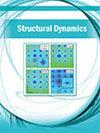Decelerated lattice excitation and absence of bulk phonon modes at surfaces: Ultra-fast electron diffraction from Bi(111) surface upon fs-laser excitation
IF 2.3
2区 物理与天体物理
Q3 CHEMISTRY, PHYSICAL
引用次数: 2
Abstract
Ultrafast reflection high-energy electron diffraction is employed to follow the lattice excitation of a Bi(111) surface upon irradiation with a femtosecond laser pulse. The thermal motion of the atoms is analyzed through the Debye–Waller effect. While the Bi bulk is heated on time scales of 2 to 4 ps, we observe that the excitation of vibrational motion of the surface atoms occurs much slower with a time constant of 12 ps. This transient nonequilibrium situation is attributed to the weak coupling between bulk and surface phonon modes which hampers the energy flow between the two subsystems. From the absence of a fast component in the transient diffraction intensity, it is in addition concluded that truncated bulk phonon modes are absent at the surface.减速晶格激发和表面不存在体声子模式:fs激光激发下Bi(111)表面的超快电子衍射
采用超快反射高能电子衍射法研究了飞秒激光脉冲辐照下Bi(111)表面的晶格激发。通过德拜-沃勒效应分析了原子的热运动。当铋体在2 ~ 4 ps的时间尺度上加热时,我们观察到表面原子的振动运动的激发速度要慢得多,时间常数为12 ps。这种瞬态非平衡情况归因于体和表面声子模式之间的弱耦合,阻碍了两个子系统之间的能量流动。此外,从瞬态衍射强度中缺少快速分量的结果可以得出在表面不存在截短的体声子模式的结论。
本文章由计算机程序翻译,如有差异,请以英文原文为准。
求助全文
约1分钟内获得全文
求助全文
来源期刊

Structural Dynamics-Us
CHEMISTRY, PHYSICALPHYSICS, ATOMIC, MOLECU-PHYSICS, ATOMIC, MOLECULAR & CHEMICAL
CiteScore
5.50
自引率
3.60%
发文量
24
审稿时长
16 weeks
期刊介绍:
Structural Dynamics focuses on the recent developments in experimental and theoretical methods and techniques that allow a visualization of the electronic and geometric structural changes in real time of chemical, biological, and condensed-matter systems. The community of scientists and engineers working on structural dynamics in such diverse systems often use similar instrumentation and methods.
The journal welcomes articles dealing with fundamental problems of electronic and structural dynamics that are tackled by new methods, such as:
Time-resolved X-ray and electron diffraction and scattering,
Coherent diffractive imaging,
Time-resolved X-ray spectroscopies (absorption, emission, resonant inelastic scattering, etc.),
Time-resolved electron energy loss spectroscopy (EELS) and electron microscopy,
Time-resolved photoelectron spectroscopies (UPS, XPS, ARPES, etc.),
Multidimensional spectroscopies in the infrared, the visible and the ultraviolet,
Nonlinear spectroscopies in the VUV, the soft and the hard X-ray domains,
Theory and computational methods and algorithms for the analysis and description of structuraldynamics and their associated experimental signals.
These new methods are enabled by new instrumentation, such as:
X-ray free electron lasers, which provide flux, coherence, and time resolution,
New sources of ultrashort electron pulses,
New sources of ultrashort vacuum ultraviolet (VUV) to hard X-ray pulses, such as high-harmonic generation (HHG) sources or plasma-based sources,
New sources of ultrashort infrared and terahertz (THz) radiation,
New detectors for X-rays and electrons,
New sample handling and delivery schemes,
New computational capabilities.
 求助内容:
求助内容: 应助结果提醒方式:
应助结果提醒方式:


